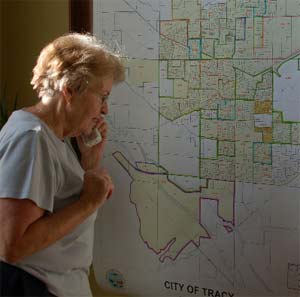 |
 |
 Truth #1: You’ll never have the money or volunteers or time you think you need in order to, say, win the initiative or turn out the Chicano vote citywide.
Truth #1: You’ll never have the money or volunteers or time you think you need in order to, say, win the initiative or turn out the Chicano vote citywide.
Truth #2: You can reach your goals with the resources you have and those you can get.
Truth #3: You can’t do it without a strong targeting strategy that concentrates resources on the areas and/or groups of people in which you’ll have the greatest impact.
Unfortunately, these truths are about the only simple thing about targeting.
So, what is targeting? The short answer is:
Here’s the long answer:
Some election organizers, like Anthony Thigpenn of SCOPE, have raised targeting to a near-science. Watch the video to hear a broad overview of SCOPE’s targeting process, or check out Anthony’s detailed and very informative PowerPoint presentation on precinct-by-precinct targeting in Los Angeles and you’ll understand the potential for targeting to be a technically precise and technologically advanced discipline. But, as he would be the first to point out, Anthony has nearly a dozen years of experience working on elections in Southern California, and many more as a community organizer. Furthermore, SCOPE has access to GIS mapping software, which allows them to geocode voter history and census data, they’ve devised formulas for calculating the number of people they need to contact that is based on their experiences in past election, and they have a massive database of voters that reflects their many years in the field.
Other organizers, newer to the election game, use little more than registration records and a blown-up city map – the paper kind. They reach and surpass their goals as well, not least because of their solid background in the communities they target for voter turnout. You already have field experience – most community organizers have been door-knocking, talking, listening and persuading people all their lives – what you require are the tools and skills that will help you to define the parameters of the electoral project and plan and prioritize work. In the video, Henry Serrano gives a nice little introduction to targeting strategy in a nonpartisan voter turnout project – the first step of most integrated voter engagement work – and highlights the fact that the crucial skill set comes from “an organizing culture.”
The jumping-off point for community organizers who want to engage in elections is, as Henry makes clear, an understanding of available resources. These include those that are internal to the organization, such as volunteers, money, membership data and experience, and external, such as demographic information and voting history. We’ll discuss resources in detail on the following page, but suffice to say that every organization has access to a limited, but not inadequate, amount. Your targeting strategy will depend upon resources – but it will be defined by the goals of the particular project.
For these reasons, there is no one way to target. But there are some basic strategies that our contributors have used, and which you’ll learn about in the following pages. Most of them began doing electoral work with relatively modest nonpartisan voter turnout projects that targeted the kind of folks that their organizations work with on a daily basis. This is probably the best introduction to electoral work, and we’ll discuss it on the Targeted Turnout page.
Every project requires a unique targeting strategy but, as you’ll see in the following pages, we’ve distinguished between two broad approaches: geographic, which involves choosing precincts or neighborhoods where your work can have the most impact, and demographic, which starts with a group of people who share similar characteristics and designs a strategy to get a large percentage of them to the polls.
But, once again, targeting’s not that simple. The demographic/geographic dichotomy is really no dichotomy at all, because most targeting strategies take into account both geographic and demographic factors. Nonetheless, the distinction is a meaningful one because it represents the dual pools of information that you’ll draw on to identify your targeted group. While both will be significant, one will take precedent.